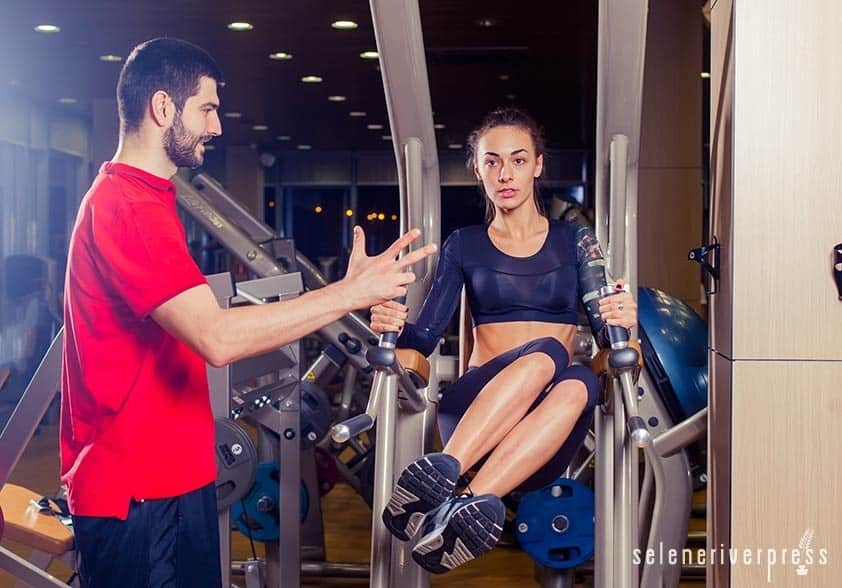There are five general health-related components of fitness that are essential to consider when teaching the basics of physical education. In health clubs and fitness facilities all around the world, these components are used as a way to measure an individual’s fitness.
As a personal trainer, I perform several fitness tests on my clients before starting our workout routine. If you don’t see a personal trainer, I recommend a self-assessment of these factors to identify your base level of fitness. The five components are:
- Cardiovascular endurance
- Muscular strength
- Muscular endurance
- Flexibility
- Body composition
#1. Cardiovascular Endurance
Also known as cardio-respiratory endurance, this measures the capacity at which blood and oxygen is delivered throughout your body to fuel continuous activity. The delivery of oxygen and nutrients begins all of our bodily processes, which makes cardiovascular endurance the most important out of all five components.
To improve your cardiovascular endurance, you need to exercise at sufficient intensity to elevate your heart rate. Remember, your heart is a muscle too. Like all muscles, it needs exercise to get stronger. There are thousands of ways to elevate your heart rate. Any cardio machine, such as a treadmill, elliptical, or stationary bike, will work.
Nutrition also plays a role. Similar to a diet of processed foods, a weak cardiovascular system can lead to multiple health problems, including heart attack and stroke.
#2. Muscular Strength
Muscular strength refers to the ability of your muscles to produce force. When your muscles contract, they can overcome opposing forces. But as these opposing forces increase, there comes a point where the muscular contraction cannot overcome it. Increasing the amount of opposing force your muscles can overcome requires developing your muscular strength. You can achieve this through resistance training with free weights, elastic bands, exercise machines, or even bodyweight exercises.
#3. Muscular Endurance
Muscular endurance is a combination of both muscular strength and cardiovascular endurance. It’s a measure of how long a muscle can overcome a force before it becomes fatigued. Whereas muscular strength refers to maximal strength, muscular endurance refers to how long the muscles can contract under a light load.
To test your muscular endurance, pick up three-pound weights and see how many times you can press them over your head before you cannot lift your arms up any longer. Another way to improve your muscular endurance is to engage in cardiovascular exercise such as walking up a flight of stairs or riding a bike.
You can also improve your muscular endurance (and even increase your stamina) with diet. Grains in particular are an excellent source of fuel associated with heightened muscular endurance. You can learn more about these great health benefits in “The Cereal Grains” by Dr. Royal Lee.
#4. Flexibility
Flexibility, or the range of motion at your joints, is an important aspect of health and injury prevention. A few factors play a role in your flexibility, including how tight or relaxed your muscles are and the mechanics of your joints.
Flexibility training comes in many different forms, with static stretching being the most common. To perform a static stretch you need to extend the muscle to its most elongated state and hold it there for time. Another form of flexibility training is known as Self-Myofascial Release, which involves putting pressure on tight muscles in order to work out knots. Yoga and Pilates classes also great ways to gain flexibility.
Diet is another important component. In order to support and maintain your flexibility, make sure to seek out the whole food vitamins and minerals you’ll need, and make sure they come from natural sources.
#5. Body Composition
Your body is composed of different types of tissues, most of which are muscle tissue. In fact, the majority of your body is made up of muscle tissue, fat, and bone. Your lean mass is considered your muscle tissue and bone.
A high percentage of body fat is associated with multiple health problems, including cholesterol, high blood pressure, and diabetes. In terms of body composition, the most significant variable is your body fat percentage, or the percent of your total body mass that’s composed of adipose (fat) tissue.
There are several ways to measure your body fat percentage. You can use calipers, bioelectrical impedance, or hydrostatic weighing. If your goal is to change your body composition, exercise and diet are the best ways to go about it.
However, to truly achieve the body composition you desire, one of the best tips I can give is to reduce your intake of sugar in combination with fat. This combination has long been known to be the cause of surplus body fat. According to Dr. Royal Lee, synthetic sugar (in the form of dextrose) was the only known form of sugar to cause diabetes in test animals. In “Calories—Nutritional and Harmful Types,” Dr. Lee states, “Hydrogenated fats promote an increase in blood cholesterol; and a high blood cholesterol is known to predispose to heart disease, hypertension, and cancer.”
This has been known for many years, yet the typical American diet still consists of large doses of synthetic sugars and fat. Reducing your consumption of them is my #1 suggestion for improving your body composition and achieving a healthy state.
Conclusion
These are the top five health-related components of fitness. My goal in writing this is to help clarify various aspects of fitness, a topic that’s confusing for many of us. For the longest time it was hard for me to understand the true components of fitness, especially how to best measure and achieve them. I hope you learned something from this article. Make sure to speak your mind in the comment section!
Image from iStock/Satyrenko.


